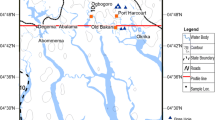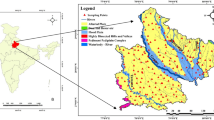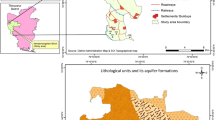Abstract
The leaching processes along the flow path and over abstraction of the alluvial aquifer, the principal aquifer in delta Tokar, by the agricultural and domestic sectors and natural factors, have led to its salinization which may be due to interaction between geological formations and adjacent brackish and saline water bodies as well as seawater transgression. The main objectives of this study are to assess the hydrochemical characteristics of the groundwater and to delineate the locations and the sources of aquifer salinization. Water samples in the project area were chemically analyzed for major cations and anions at the laboratory by the standard analytical procedures. Chemical data and water level measurements were manipulated using GIS techniques for hydro chemical and flow direction maps and piper diagram for chemical facies and SPSS software for statistical analyses such as basic statistics (mean and standard deviation) and Spearman’s correlation matrix. The general flow direction of the groundwater is from Southwest towards East and Northeast. The hydraulic gradient is relatively steeper at the apex of the delta (0.06) and amounts to 0.005 at the distal part of the delta. The average transmissivity value of the water bearing formations was found to be about 4.5 × 103 m2/s, whereas, the storage coefficient was about 0.28. A hydrochemical study identified the locations and the sources of aquifer salinization and delineated their areas of influence. The investigation indicates that the aquifer water quality is significantly modified as groundwater flows from the southwestern parts of the study area, where the aquifer receives its water by lateral underflow from Khor Baraka flood plain, to the central and northeastern parts, with few exceptions of scattered anomalous concentration pockets in the deltaic plain. Significant correlation between TDS and/or EC with the major components of Na+, Cl−, and SO −24 ions is an indication of seawater influence on the groundwater salinity. Moreover, Cl−, SO 2−4 , and Na+ are predominant ions followed by Ca2+ and HCO −3 . Hence, four types of groundwater can be chemically distinguished: Na–Ca–SO4–Cl– facies, Na–Cl–SO4–HCO3– facies, Na–Ca–Mg–SO4–Cl–HCO3 facies, and Na–Ca–Mg–Cl–SO4 facies. The processes that govern changes in groundwater composition as revealed by chemical and statistical analyses are mainly associated with over-abstraction, biodegradation, marine intrusions, and carbonate saturation.
Similar content being viewed by others
Explore related subjects
Discover the latest articles, news and stories from top researchers in related subjects.Avoid common mistakes on your manuscript.
Introduction
Groundwater in coastal aquifers at the semi-arid region in Sudan receives increasing stress because it is the only water resource contributed by anthropogenic factors. Groundwater quality deterioration in such areas may be due to seawater intrusion, water–rock interactions, and anthropogenic resources (Emmanoel et al. 2009; Bouragba et al. 2011). The aquifer in Delta Tokar contains a freshwater lens, floats above a denser saline water wedge penetrates more than 40 km landwards. Development of agriculture and other land use changes pose a potential threat to the quantity and quality of freshwater resources on the area. The project area is located in the southeastern part of the Red sea State at about 200 Km. southeast of Port Sudan town. It lies between latitudes 18°18′–18°40′ and longitudes 37°35′–38°50′ E (Fig. 1), covers an area of about 10,000 km and characterizes by a prolific soil favorable for agriculture activities.
Geomorphology, geology, and hydrogeology
The area lies in the semiarid to sub-humid zones. The mean annual rainfall is about 150 mm mainly during May–September and to less extend during winter (Nov–March). The area is characterized by scattered acacia trees with an increasing density pattern landward. Morphologically, the area can be subdivided into the coastal plain zone, the red sea hills, and the wash zone plateau in between. Ephemeral Khor Baraka and its branches are the main source of recharge to the aquifers during the flood seasons (56 × 107 m3/year, May–Sept) in addition to direct precipitation. The area consists of a crystalline basement complex of gneissic and granitic rocks (Whiteman 1971) dissected by some late post-granite diabase dikes and quartz veins. The sedimentary formations along the Sudanese Red Sea coast generally constitutes Mukwar, Hamamit, Magarsum, Abu Imama, Dungonab, and Abu Shagara formations (Sentini 1965). Abu Shagara, is the youngest formation which include marine and continental calastic deposits and reef limestone of Pleistocene and recent age overlying the above formations (Carella and Scarpa 1962; Berry et al. 1966).
The crystalline rocks at the study area were covered unconformably by marine Tertiary–Quaternary sediments, which were covered by unconsolidated talus, alluvial deposits, hairmada, and sand dunes. The Pleistocene deposits vary in thickness from 30 to 40 m and compose of unconsolidated silt, sand, gravel, and boulders, extensively cover the coastal plain in form of coarse clastic sediments. The marine sediments are mainly consisting of reefs, carbonates, gypsum, and rock salt, deposited along the sea shore (Basheriek 2009), overlain by clastic sediments along the coastal plain. Groundwater occurs in the unconsolidated continental and marine sediments underwater-table and semi-confined conditions (Hussein 1986). The inhabitants depend mainly on groundwater for their domestic and agriculture activities. The main geological and hydrogeological factors affecting the groundwater quality include; aquifer's lithology, rainwater and seawater transgression. Hydrogeologically, soils differ in their infiltration capacity in different parts of the delta depending upon the kind of soil. The alluvial soil, which occupies the deltaic plain, is fertile with very high clay content. The soil of the coastal tract is occasionally saline, coarse textured with sandy sub-soils.
Methodology
The chemical condition of natural water can be evaluated either by mathematical equations, graphs, or hydro chemical maps. These methods are used to illustrate chemical relationship through different waters, probable sources, areal-water- quality regimen as well as water pollution. Numbers of water samples and water level measurements were collected from shallow wells and boreholes in the study area, and chemically analyzed and evaluated. The pH was measured at the spot, whereas the concentration of major cations and anions were analyzed at the laboratory by the standard analytical procedures. Sodium and potassium were analyzed using flame photometer. Calcium, magnesium, chloride, and bicarbonates were estimated by titrimetric methods using relevant reagents (Grasshoff et al. 1983; APHA 1985). Sulfate ion concentration was carried out using double beam UV–visible spectrophotometer. Spatial visualization of chemical species and flow direction map in the project area were performed using GIS techniques. Aquifer parameters and type of chemical faceis were appraised using pumping test techniques and piper diagram, respectively. The statistical tests applied, for basic statistics (mean and standard deviation) and Spearman's correlation matrix, were done using SPSS computer software.
Results and discussions
The elevation of water level in Delta Tokar has been measured in a number of wells distributed throughout the area where water level contour map was constructed (Fig. 2). Accordingly, the general flow direction of the groundwater is from Southwest towards East and Northeast. Cones of depressions were visualized in the southwestern and westcentral part of the study area (Fig. 2) which is ascribed to over abstraction in these areas. Outward flow direction around well number (5) at the southeast part, was attributed to heavy pumping around this zone. The hydraulic gradient is relatively steeper at the apex of the delta (0.06) and amounts to 0.005 at the distal part of the delta. This phenomenon is attributed to permeability variation of the heterogeneous and lateral facies changes of the recent alluvial and marine deposits of the delta. The aquifer and well tests were conducted in many parts of the area with the appropriate pumping test methods. Hence, the average transmissivity value of the water bearing formations was found to be about 4.5 × 103 m2/s, whereas the storage coefficient was about 0.28.
Due to ion exchange and precipitation of least-soluble salts, the chemistry of water is modified as it flows through the geological terrains. The basic properties of groundwater (pH, electrical conductivity (EC), and total dissolved solids (TDS)), and major components (Ca, Mg, Na, K, Cl, HCO −3 , and SO4,) are shown in Table 1 and discussed in the following paragraphs:
The pH values of groundwater in the study area were between 8.6 and 7.6, reflecting alkaline behavior of the groundwater (Table 1). The slight alkaline nature of groundwater as deduced from the pH, may be due to the presence of fine aquifer sediments mixed with clay and mud. Variations of the electrical conductivity of the groundwater (4,120–1,052 μmhos/cm) were related to the variations of salinity, indicating an influence from seawater intrusion.
Total dissolved solids vary between 3,804 and 692 mg/l with an average of 2,172 mg/l (Table 1), indicate the present of brackish to saline waters. Spatial distribution indicates high TDS zone at the southwestern part of the area (Fig. 3a) which may be related to mudstones beds intercalation and low groundwater circulation rate. Scattered TDS anomalous zones at central and northwestern part are related to evaporite deposits and anthropogenic activities.
Sodium varies from 1,050 to 55 mg/l and the average value is 537 mg/l (Table 1). The spatial distribution of sodium ions shows a tendency of increasing concentration at the southwest and scattered close bodies at central part (Fig. 3b). Sodium ion concentrations come mainly from weathering of alkali-feldspars and plagioclase of rocks related to the recharge areas and halite deposits of the deltaic plain. Although the concentration of potassium is high in the granitic rocks, due to its low mobility in the hydrosphere, potassium concentration values obtained are low and of minor effect in the groundwater system (Table 1).
Calcium ion concentration varies between 424 and 26 mg/l with an average of 156 mg/l (Table 1). The spatial distribution of calcium, reflect a tendency of increasing along the flow direction forming a close bodies at the center, north and southwestern part of the Delta (Fig. 3c). This may be attributed to ion exchange and dissolution of marine bicarbonate deposits.
Chloride ion concentration varies between 1,456 and 216 mg/l with an average of 642 mg/l. (Table 1). The spatial visualization of chloride in the study area, reflects a tendency of increasing at southwestern and central part forming a close bodies (Fig. 3d). Chloride ion concentrations may be associated with, natural brine, evaporites deposits pollution, and sea-salt sprays (Silva et al. 1999).
Bicarbonate ion concentration varies between 366 and 207.40 mg/l with an average of 275.27 mg/l (Table 1). Bicarbonate ions reflect a relatively defined pattern, with concentration levels increasing at the central part of the area (Fig. 2e). This may be associated to infiltrating water that has incorporated dissolved CO2 from root respiration and decay of soil organic matter. However, the main source of bicarbonate (alkalinity) for groundwater in this region is the decay of sediment/soil organic matter and marine bicarbonate deposits.
Sulfur is widely present in reduced forms (e.g., metallic sulfides) in igneous, sedimentary, and metamorphic rocks (Hem 1985). Sulfate ion concentration is the second predominant anions in the study area. It varies between 1,112 and 219 mg/l with an average of 516.75 mg/l (Table 1). The spatial distribution of sulfate reflects a tendency of increasing along the flow direction forming close bodies at the central, northern, and southwestern part of the delta (Fig. 2f). Pyrite dissolution from diabase dikes or sea-salt sprays and marine intrusion can be responsible for most of sulfate inputs into the groundwater of the study area as evidenced by its significant correlation with N+ and Cl−, respectively (Table 2).
According to Spearman's correlation, it was found that the correlation between TDS (salinity) and/with the major components of seawater (Na+, Cl−, and SO −24 ) showed significance correlation (TDS—Na+, r = 0.903; TDS—Cl−, r = 0.957; and TDS—SO −24 , r = 0.928 with; p < 0.01, Table 2); that reflects signs of seawater influence on the groundwater salinity. The significant correlation of SO 2−4 ion with Na+ and Cl−, (SO −24 –Na+, r = 0.823; SO −24 –Cl−; r = 0.914) reflects signs of marine intrusion to groundwater in the area (Table 2). The main contributors to the groundwater salinity are Na+, Ca2+, Mg2+, SO −24 , and Cl−, that shows significant correlation with EC similar to TDS (Table 2). The variation of these relationships may indicate the complexity of the hydrochemical components of groundwater where natural water always contains dissolved and suspended substances of mineral origin. The processes govern changes in the groundwater composition are mainly associated with over abstraction, biodegradation, carbonate saturation, and sea water intrusions. Principally, the intrusion may be attributed to the groundwater's over abstraction and/or the effect of sea tides (Bear et al. 1999; Abdullah et al. 2002; Gallardo and Marui 2007).
Piper diagram (1944) can define the patterns of spatial change in the water chemistry among geological units, along a line of section or along a path line (Raji and Alagbe 1997; Domenico and Schwartz 1998). The results of the chemical analyses of the total wells in the study area were plotted on piper diagrams (Fig. 4) for hydrochemical facies. Hence, groundwater is significantly dominated by Na+, Cl−, and SO 2−4 , followed by Ca2+ and HCO −3 , reflecting mixed sources of water drainage from gneiss and granitic terrain at the western border of the area and gypsum (evaporites) of marine deposits at the coastal line and sea water transgression. The position of the groundwater in the anions triangle indicates dominance of the Cl− and SO −24 , but comparatively low bicarbonate in the waters. Consequently, four types of groundwater can be chemically distinguished: Na–Ca–SO4–Cl– facies; Na–Cl–SO4–HCO3– facies, Na–Ca–Mg–SO4–Cl–HCO3 facies, and Na–Ca–Mg–Cl–SO4 facies. It is worth noting the change in anion content in the groundwater, decreasing bicarbonate, and increasing sulfate concentration. An example supporting this observation is the increase in Cl− and SO 2−4 concentrations in the waters of the Na–Ca–SO4–Cl– facies.
Conclusion
The hydrogeological characteristics of the study area reflect that the general flow direction of the groundwater is from southwest towards east and northeast where. The hydraulic gradient is relatively steeper at the apex of the delta (0.06) and amounts to 0.005 at the distal part of the delta. The average transmissivity value of the water bearing formations was found to be about 4.5 × 103 m2/s, whereas, the storage coefficient was about 0.28.
A hydrochemical study identified the locations and the sources of aquifer salinization and delineated their areas of influence. The investigation indicates that the aquifer water quality is significantly modified as groundwater flows from the southwestern parts of the study area, where the aquifer receives its water by lateral underflow from Khor Baraka Flood plain, to the central and northeastern parts, with few exceptions of scattered anomalous pockets in the deltaic plain. Significant correlation between TDS and/or EC with the major components of Na+, Cl−, and SO −24 is an indication of seawater influence on the groundwater salinity. According to piper diagram, four types of groundwater can be chemically distinguished: Na–Ca–SO4–Cl– facies, Na–Cl–SO4–HCO3– facies, Na–Ca–Mg–SO4–Cl–HCO3 facies, and Na–Ca–Mg–Cl–SO4 facies. The processes that govern changes in the groundwater composition are mainly associated with over-abstraction, biodegradation, marine intrusions, and carbonate saturation.
References
Abdullah M, Kassim M, Hanapi M (2002) Saltwater encroachment into the sandy aquifer of Manukan Island, Sabah. Borneo Sci 12:1–22
APHA (1985) Standard methods for the analysis of water and waste water, 16th edn. American Public Health Association, Washington
Basheriek K (2009) Image interpretation and GIS techniques in mapping and exploration for groundwater and minerals, Red Sea Hills, NE Sudan: MSc. Thesis U of K, Sudan
Bear J, Cheng A, Sorek S, Ouazar D, Herrera I (1999) Seawater intrusion in coastal aquifers–concepts, methods and practices. Kluwer, Dordretch
Berry L, Whiteman AJ, Bell SV (1966) Some radiocarbon dates and their geomorphological significance, emerged reef complex of Sudan. Z Geomorphol N Folge 10:119–143
Bouragba L, Mudry J, Bouchaou L, Hsissou Y, Tagma T (2011) Characterization of groundwater in the Souss upstream basin: hydrochemical and environmental isotopes approaches. Afr J Environ Sci Technol 5(4):307–315
Carella R, Scarpa N (1962) Geological results of exploration in Sudan by AGIP Mineraria Ltd. Rep. 4th Arab Pet. Congr., Beirut
Domenico P, Schwartz F (1998) Physical and chemical hydrology, 2nd edn. Wiley, New York
Emmanoel V, Renato G, Christophe E, Bernard B, Silvia S, Michel D, Roland S, Julio W (2009) Groundwater chemical characterization of a Rio de Janeiro coastal aquifer, SE–Brazil. J S Am Earth Sci 27:100–108
Gallardo A, Marui A (2007) Modeling the dynamics of the freshwater-saltwater interface in response to construction activities at a coastal site. Int J Environ Sci Technol 4(3):285–294
Grasshoff K, Ehrhardt M, Kremling K (1983) Method of sea water analysis, 2nd edn. Vorlagchemie, Weinheim
Hem J (1985) Study and interpretation of the chemical characteristics of natural water. US Geological Survey Water Supply Paper 2254, pp 263
Hussein M (1986) Groundwater potentialities of the Eastern Region of the Sudan, International conference on Water Resources Needs & planning in Drought Prone Areas, Khartoum
Raji B, Alagbe S (1997) Hydrochemical facies in parts of the Nigerian basement complex. Environ Geol 29:46–49
Sentini J (1965) Cenozoic stratigraphy and depositional history, Red Sea Coast, Sudan. AAPG 9:1453–1472
Silva E, Pedlowski M, Paiva R, Wasserman J, Lacerda L (1999) Atmospheric inputs to ecosystems to the East Fluminense coast, State of Rio de Janeiro, Brazil. pp 71–87
Whiteman A (1971) The geology of the Sudan Republic. Clarendon, London
Acknowledgments
Authors are indebted to and thanked all contributors and official authorities that gave any assistance to this research to be published.
Author information
Authors and Affiliations
Corresponding author
Rights and permissions
About this article
Cite this article
Elkrail, A.B., Obied, B.A. Hydrochemical characterization and groundwater quality in Delta Tokar alluvial plain, Red Sea coast—Sudan. Arab J Geosci 6, 3133–3138 (2013). https://doi.org/10.1007/s12517-012-0594-6
Received:
Accepted:
Published:
Issue Date:
DOI: https://doi.org/10.1007/s12517-012-0594-6








